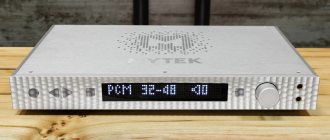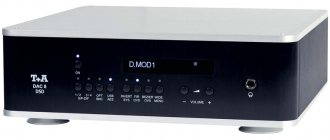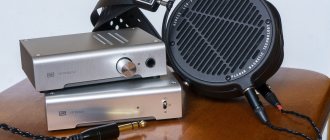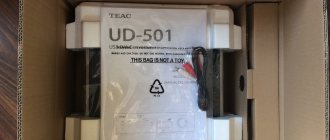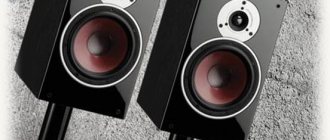Upgrading a stereo system most often leads not only to additional costs, but also to an increase in the number of components in the rack. To make headphones sound better, you need a separate amplifier, to make records sound good, you need a hefty phono preamplifier, and using an integrated amplifier in an adult system is generally bad form, only pre- and monoblocks! In the High End world there is no other way, but if you turn to professional technology, options are possible. One of them is Mytek Brooklyn DAC+.
DAC with plus
In the Mytek Brooklyn DAC+ line, it occupies a middle position. The junior Liberty DAC model is super-compact and performs three functions: a DAC, a digital preamplifier and a headphone amplifier. The Brooklyn DAC+ isn't much larger, but it's enough to outperform its smaller brother in terms of sound quality and provide a ton of additional features.
At the heart of everything is the average model of a professional DAC from the ESS Saber 9028 Pro line. The digital part, among other things, has an additional Wordclock input/output clock generator, so the DAC can be synchronized with digital transport or make both devices operate from an external clock.
It's amazing how many functions can be packed into a package 1/2 the size of a standard one.
There is almost no space left on the rear panel, but we managed to fit everything we needed, even the trigger control
By the way, the device itself has an internal jitter of 0.82 ps, therefore, without an external generator in the system, it makes sense to leave the Mytek Brooklyn DAC+ as the main one. Thanks to two SPDIF inputs that can operate in parallel, the DAC is able to receive two DSD streams instead of one, increasing the interface bandwidth to DoP DSD256 and allowing for multi-channel DSD operation. All this, however, does not negate the presence of a USB input that accepts DSD256 in native format.
With analog switching, things are no less interesting for the Brooklyn DAC+. The first thing that catches your eye is the balanced outputs on XLR connectors. The younger Liberty also had them, but on large 6.3 mm jacks or TRS connectors, which is not very convenient when integrating the device into a home system. High-end XLR to TRS cables are not that easy to find. Here everything looks quite familiar and is connected as standard. But all these are flowers against the background of the fact that the Brooklyn DAC+ has an analog input - and even with a connected MM/MS phono preamplifier.
Instead of the built-in switching power supply, you can use an external linear or powerful 12 V battery
The third feature of the model: the presence of a dual headphone amplifier, which allows you to connect two pairs at once with different characteristics that will not negatively affect each other’s operation, or use a special adapter to connect one pair in balanced mode. What is typical: the device recognizes the fact that a balanced adapter is connected and turns on the corresponding operating mode automatically.
Another subtlety: when using the headphone outputs in unbalanced mode, they are equivalent in everything except the signal phase. The left output outputs direct and the right output inverted phase, so if you think they sound a little different, that's okay - there really is a difference.
Mytek Brooklyn DAC+ review: USB DAC on ES9028Pro and balanced headphone amplifier
Our readers already know Mytek from our review of their flagship product Manhattan DAC II on the ES9038Pro. With all its advantages and abundance of functions, the high price does not allow us to recommend the Manhattan DAC II to everyone. However, the manufacturer has an equally interesting DAC model, the Mytek Brooklyn DAC+ (page on the manufacturer’s website) with very similar hardware and a much more attractive price tag. It also has in common with the older model a full set of digital connections, balanced line outputs, and the ability to connect balanced headphones. But the Brooklyn DAC+ also has its own advantages: a more compact body and two color OLED screens.
The manufacturer has professional roots and produces its products, including for recording and mastering studios, and this is clearly visible in the advanced capabilities of the device. It is clear that the engineers carefully approached the design and implemented all their ideas into the Brooklyn DAC+. Just look at the correct professional columnar level indicators - picmeters. They have two scales: peak and root mean square. Thus, both the real loudness of the composition and its peak factor are immediately visible. In addition to the most detailed multi-segment scale, there is also a digital indication of the exact level in decibels down to tenths. All this immediately suggests that this product is a real branded item, and not some rootless Chinese box with banal XMOS+ESS+OPA inside.
If you don’t like jumping color indicators, you can select a quieter screen mode, where the current operating modes will be highlighted. There is also an MQA indicator for modern streaming services. There is auto-detection for connecting headphones to the jack on the front panel. Moreover, there are four modes that can be selected: only line output, only headphone output, both at the same time, and automatic detection. Control is possible not only from the front panel, but also from the remote control. That is, the convenience of the user was taken care of down to the smallest detail.
The rear panel has interesting advanced digital connectivity options. There is an input for a professional digital AES signal, Toslink and two S/PDIF inputs. There are even WordClock coaxial connectors for synchronizing with studio equipment. For audiophiles, there is a line input with the ability to work as a phono stage and a ground connection for a turntable. Of course, there are also line outputs, these are unbalanced stereo RCA and balanced stereo XLR.
Interestingly, there are two types of volume control available: digital and analog. The type of adjustment is selected by the user in the menu. By analogue control we mean a microcircuit inside the device that changes the signal amplification after the DAC. In both cases, the adjustment is done as efficiently as possible; it is more a matter of taste and preference.
The device uses an internal switching power supply powered from a 100-240 V network. However, true purists can power the device from a linear power supply or from a battery. There is a separate 12 V socket on the back for this purpose.
Interestingly, there are holes for ventilation not only at the bottom and top of the case, but also in the printed circuit board itself. This bears fruit: during operation, the device body is warm, but not hot.
There is nothing bad to say about the switching power supply. It is quite powerful and well shielded. According to our measurements, the signal/noise is 119 dBA, the spectrum of the analog signal at the outputs is very clean and has no interference.
A very interesting digital filling consists of four different digital chips. Here you can see XMOS, STM32, FPGA Altera Cyclon V and NXP microcontroller. Each chip is solely responsible for its own functions. The XMOS XU216 chip is responsible for receiving audio data and drivers for USB. Next to it are audio quartz oscillators.
The DAC chip is a very high-quality ES9028Pro converter with an outstanding dynamic range of 133 dB and a noise ratio of −120 dB. Other audiophile components, such as German Wima film capacitors or special audiophile resistors, correspond to the developers' ideas about high-quality sound.
The control panel allows you to see all current device modes at once, and also has a buffer size setting.
Device: Mytek USB Audio
Features: Input channels: 4 Output channels: 2 Input latency: 710 Output latency: 551 Min buffer size: 8 Max buffer size: 2048 Preferred buffer size: 512 Granularity: −1 ASIOOutputReady — not supported Sample rate: 8000 Hz — not supported 11025 - _ supported Input channels: channel: 0 (AES L) — Int32LSB channel: 1 (AES R) — Int32LSB channel: 2 (SPDiF1 L) — Int32LSB channel: 3 (SPDiF1 R) — Int32LSB Output channels: channel: 0 (Output L) — Int32LSB channel: 1 (Output R) — Int32LSB
ASIO drivers allow you to record from digital inputs, as well as output the signal to a stereo output. You can use the device for professional purposes. Supports modes up to 768 kHz and DSD256 playback in Native and DoP modes.
Testing in RightMark Audio Analyzer
| Device under test | Mytek Brooklyn DAC+ |
| Operating mode | 24-bit, 44 kHz |
| Audio Interface | ASIO |
| Signal route | External loopback (line-out - line-in) |
| RMAA version | 6.4.5 |
| Filter 20 Hz - 20 kHz | Yes |
| Signal normalization | Yes |
| Level change | 0.7 dB / 0.7 dB |
| Mono mode | No |
| Calibration signal frequency, Hz | 1000 |
| Polarity | correct/correct |
| Frequency response unevenness (in the range 40 Hz - 15 kHz), dB | +0,06, −0,05 | Great |
| Noise level, dB (A) | −118,6 | Great |
| Dynamic range, dB (A) | 118,3 | Great |
| Harmonic distortion, % | 0,00033 | Great |
| Harmonic distortion + noise, dB (A) | −105,7 | Great |
| Intermodulation distortion + noise, % | 0,00088 | Great |
| Interpenetration of channels, dB | −99,9 | Great |
| Intermodulation at 10 kHz, % | 0,00053 | Great |
| Overall rating | Great | |
We see expectedly excellent results when testing the linear output. By the way, like the Mytek Manhattan II, the maximum signal amplitude at the RCA outputs of the Brooklyn was an impressive 4 VRMS.
We listened on American Martin Logan stereo speakers. We listened to both electrostats for 1.5 million rubles, and more popular 35XT from the same manufacturer, with AMT tweeters, for 75 thousand. I liked the regular Martin Logan speakers more than the electrostats - they seemed somehow more familiar and clearer to the ear. Perhaps for electrostats you need to select the amplifier they need so that they sound at full strength. Their potential is felt, but it is also clear that they are very demanding on the volume of the room and its decoration. In addition, we had an excellent opportunity to switch to other signal sources while listening, including the Mytek Manhattan II and other high-quality DACs whose sound we know well.
In our opinion, the Brooklyn DAC+ is very interesting and is not much inferior in sound to the older Mytek model. Overall I liked the sound of Brooklyn: it is very captivating, comfortable, with good detail, but without aggression. For audiophile listening, this turns out to be a very interesting option. Of course, it’s hard not to notice the recognizable signature of the ES9028Pro chip itself, which is expressed in exceptionally well-developed high frequencies and a wide stereo panorama. Each sound has its fans and anti-fans. Some people like multi-beaters, others have other ideas about the ideal, so you need to listen and choose expensive equipment personally. The more experience the listener has, the easier it is for him to make an informed choice. In a review, you can only talk about the main features, but not make a choice for everyone. There is no right or wrong decision here; one source has some of its own strengths, but may be inferior to another in something else. So take your favorite recordings and enrich your experience. Look for what suits you best, and you will definitely find your ideal.
We tested the headphone output on headphones from Audeze and other high-quality brands. This is quite an option, but, as with the flagship Manhattan II, we believe that the main purpose of the Mytek devices is to act as a pure DAC. But it makes sense to connect an external specialized amplifier to the Brooklyn linear output.
conclusions
Mytek Brooklyn DAC+ once again confirmed the reputation of the American manufacturer. We saw a very careful approach to everything, which bore fruit in the form of an interesting product with a bunch of useful features and high-quality sound. It will be of interest to owners of not the cheapest audiophile equipment who are looking for comfortable, detailed sound. It is important that modern hardware allows you not only to listen to the Hi-Res collection in any PCM and DSD formats, but also to join the latest MQA streaming services via the Internet. We will closely monitor Mytek and wait for new breakthrough developments based on the most modern technical achievements.
Who's at the helm?
In order to understand how to operate this thing and configure all the parameters correctly, you need detailed instructions (they are included in the kit), as well as a decent amount of time and enthusiasm.
The control mechanics of the Mytek Brooklyn DAC+ are implemented as a combination of icons displayed on the display, four buttons and a rotary knob with a push function. Four buttons (located in pairs on either side of the display) provide direct access to four menu sections: volume, inputs, operating modes and digital settings. The selection of the desired menu section is carried out using buttons, to understand the functions of which four icons are displayed on the screen, and the main manipulations are carried out using a rotary knob.
Design and workmanship are the strong point of the Mytek brand
The small display is extremely informative
There is a clear, but completely unusual logic in all this. At first, this causes nothing but irritation due to regular erroneous actions, caused partly by the control algorithm, and partly by the abundance of abbreviations and the oversaturation of the screen with various types of information and display. But literally a few moments before committing a senseless and merciless act of violence against an innocent Hi-Fi device, the necessary automaticity is developed and the control begins to seem simple, convenient and completely logical. But it will be almost impossible to explain this to a beginner. But you can demonstrate masterly skills in navigating the device menu.
What will such unique practical skills give? In fact, quite a lot, since literally everything is customizable with the Mytek Brooklyn DAC+. At the DAC level, you can disable the MQA decoder, select from seven PCM digital filters and three DSD frequency filters, manually set the clock generator, and set up a limiting mode for volume control when connected to a computer.
Buttons and knob rotation give full access to device control
All indications are clear and understandable
Controlling volume on a device is a separate topic. Here you can choose either an analog or digital controller, depending on personal preferences and system configuration. Bypass mode - without volume control as such is also available. Depending on the system configuration, you can also switch the analog input mode from linear to MM or MS phono stage, turn the outputs on and off, or do it in automatic mode, when connecting headphones turns off the signal on all other outputs.
In a word, the Mytek Brooklyn DAC+ has everything that can be adjusted, adjusted and configured, including even the brightness of the LED backlight and pictures on the screen. This differs diametrically from the traditional high-end approach, while expanding the scope and scenarios of application of the device and allowing the user to decide for himself how it is convenient for him to connect the equipment and in which setting the system will sound better.
Is this even legal?!
The design and build quality of the Mytek Brooklyn DAC+ case is absolutely impeccable. The complex texture of the facade and the perforation in the form of a logo are made perfectly, the parts fit together with the smallest possible gaps, the edges are extremely clear, almost sharp, and the distribution of connectors on the rear panel seems to have been organized by the world champion in Tetris. By the way, it wouldn’t hurt to remind you that the line also includes a network player and a Brooklyn amplifier, thanks to which connoisseurs of beauty can assemble a chic stereo system. By the way, as in the case of Mytel Liberty, the dimensions of the Brooklyn DAC+ are not accidental - in terms of its façade, it is half of a standard 1U rack component.
The Brooklyn DAC+ may get lost in a traditional hi-fi system, but it can radically reduce the number of components
In addition to the fact that the Mytek Brooklyn DAC+ is visually and tactilely pleasing, it also pleases a lot in the little things. For example, even at the stage of connecting and mastering the device control algorithms, I noticed that two signal level indicators were displayed on the screen - corresponding to the input and output. This greatly simplifies the system setup procedure when the source is a computer or network player that has its own volume control. But choosing between the two built-in volume controls can be difficult. “Digital” and “analog” differ in nature, but are quite close in many objective parameters, including detail and tonal balance. You will have to go through a lot of different records to make a final decision.
But what you don’t have to hesitate too much with is the assessment of the sound. I would like to start with a conclusion that is simple and laconic: the Mytek Brooklyn DAC+ is unforgivably good both in its price group and as a representative of the Hi-Fi/High End world in general. His younger brother had a chance to receive at least some unflattering epithets: if desired, one could call him too strict and analytical in order to be homely, or complain that in the bass range he does not get to the bottom of the infra-low. With the Mytek Brooklyn DAC+ such claims will not work.
The built-in headphone amplifier handles even heavy loads reliably
It sounds even more detailed and also richer in timbre, which makes the sound perceived as absolutely alive, realistic and musical (if the content actually implies this). With the depth and fullness of the bass, no restrictions are felt and there is plenty of it in quantity. And most importantly: the device does not show snobbery either in terms of genres or in the issue of content quality.
If you listen exclusively to audiophile jazz in MQA and Hi-Res or DSD copies of rare vinyl pressings made before 1976 made under the full moon, you will hear the smallest nuances and shades of sounds in all their fullness and pristine purity. Well, if you sometimes like to turn on something from Russian rock or pop music of the late 90s from YouTube or from a thematic public page on VKontakte, compression artifacts will not cause physical pain, and the characteristic sound engineering and even its absence will not become an obstacle to receiving those same emotions and impressions. In all these matters, Mytek Brooklyn DAC+ is as tactful and professional as possible. It doesn't hide content quality problems, but it doesn't bring them to the fore either.
The remote control is offered in the style of early Apple design
In general, the difference between the Liberty and the Brooklyn DAC+ is such that the work of the former begins to seem simplified and schematic, while the latter allows you to experience the music in its entirety. To preserve the coordinate system, let me remind you that Liberty is very good in its class - it just so naturally happened that the Brooklyn DAC+ is better.
Keep your balance!
All of the above is true for both the Mytek Brooklyn DAC+ operating as part of a system with acoustics and for using it with headphones, but since both scenarios can be implemented in both balanced and unbalanced mode, some explanations and clarifications are necessary.
Working as a DAC, the balanced output produces sound that is more focused, transparent and detailed than the unbalanced output. The sound stage is more voluminous and clearer. Small nuances are worked out more accurately and become more legible. The difference in sound quality is not radical, but these are just those important little things that every audiophile chases. Thus, the transition from conventional power amplifiers to balanced ones can be one of the steps in upgrading the system.
With a headphone amplifier the situation is somewhat different. If you use average dynamic headphones that are not a complex load and do not have extremely low or high impedance, the difference in the sound of a balanced and unbalanced connection will come down mainly to the width of the soundstage. In both cases, the sound is extremely detailed, clear and well controlled.
A set of Hi-Fi equipment may look like this
If you listen more closely, you will notice that the balanced version is a little more accurate in small details and better at dynamic moments - so that pauses in symphonic music hang somehow especially impressive. But the more complex the load, the more noticeable the advantage of balanced amplification becomes. For planar models, I definitely recommend a balanced connection. This is the only way to achieve clear, controlled bass and decent dynamics.
Thus, we can draw simple conclusions that balanced circuitry is good in principle, and in this case it is a guaranteed way to get maximum quality from the device.
The Brooklyn DAC+ combines a digital-to-analog converter, preamp, balanced headphone amplifier, phono stage, low latency audio interface, and high-end studio monitoring system into one.
A large set of digital inputs makes it possible to connect high-end professional and home equipment. Rich in functionality, the Brooklyn DAC+ is easy to use and intuitive to use. All the necessary information, including sampling frequency, bit depth and signal level, is displayed on a large, convenient display. Through the simple and user-friendly Mytek Control Panel application, you can control the device from a PC or Mac computer. Updated software, available free of charge on the manufacturer's website, is the key to full compatibility with the latest versions of operating systems. In addition, the firmware will allow you to constantly keep the functionality of the Brooklyn DAC+ up to date. And no additional payments!
The Brooklyn DAC+ differs from other similar devices in its reference quality signal processing and musical sound.
Digital-to-analog converter
The high-quality Saber 9028PRO chipset and ultra-precise clock generator make music sound natural and precise. The new and improved analog section provides high channel separation and reduced noise.
Brooklyn DAC+ provides absolutely fair and undistorted audio playback. The sound is not only transparent, but also very musical. Thanks to this, the user can be sure that he hears the same thing that the performer and sound engineer heard in the recording studio. In addition, the device has the function of hardware decoding of the MQA format! To use this and other advanced features, use popular programs like JRiver, Audirvana and Foobar2000+.
Classic audio I/O interface
The Brooklyn DAC+ also functions as a standard compact interface, with eight input channels and two output channels operating with pinpoint precision. Digital connectors make it possible to connect any ADC, microphone preamp, synthesizer or other source with AES, S/PDIF or TOSLINK connectors. Up to four such devices can be connected. All digital channels are displayed simultaneously in a special recording program. ASIO drivers will provide a convenient process for working on complex projects that use virtual instruments and effects (AAX, VSTi, VST, AU). The device is compatible with any recording software. Whether it's Pro Tools, Cubase, Samplitude, Studio One or Ableton Live, the Brooklyn DAC+ will work with any of these programs.
The Brooklyn DAC+ was created for people who master and mix via computer. It will also appeal to those who don't need a lot of channels but appreciate high-quality digital-to-analog processing.
Balanced headphone amplifier
The Brooklyn DAC+'s built-in high-quality, powerful amplifier can drive any headphone for accurate, dynamic sound. You can connect one balanced headphones or two pairs of regular headphones to it.
Phono stage
Vinyl has become popular again, so record fans will appreciate the ability to connect an LP player directly to the analog input of a DAC. Yes! The Brooklyn DAC+ is equipped with a quality phono stage that is compatible with both MM and MC cartridges.
Reference Level Monitoring for Recording Studios
Mytek transducers have always been considered one of the most accurate and musical systems on the market. That's why they are used in studios around the world. During recording, mixing and mastering, the most reliable signal monitoring is required. The Brooklyn DAC+, with its precision accuracy, is the ideal solution for studios looking for a DAC that connects between their digital workstation and the final monitoring/listening system.
From a music producer's perspective, ideal digital-to-analog conversion quality is a must for a successful music product. If there are errors in the mix, the Brooklyn DAC+ will immediately show them. The device has a very detailed sound at all frequencies and at the same time conveys the integrity and unity of the musical composition.
Peculiarities:
- Reference D/A converter supporting PCM 32-bit/384 kHz, DSDx256
- Audio interface mode: 8 digital channels / 2 analog output channels
- Built-in reference phono stage for MM/MC cartridges
- Dual mono headphone amplifier (1.5 W per channel) with the ability to connect balanced headphones via a special adapter
- Hardware MQA decoder for creating MQA master recordings and playing Tidal Master audio format
- Set of digital connectors: USB, AES, S/PDIF x 2, SDIF L/R, Toslink, Word Clock, USB connection without drivers for MacOS and Linux
- ASIO drivers for Windows 7, 8, 10
- Ability to control all options through the Mytek Control Panel application when connected via USB or directly through the panel on the device itself
